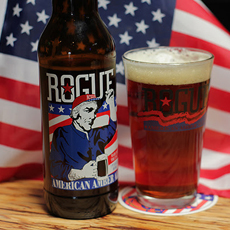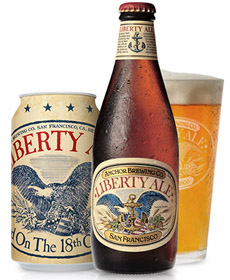|
Oregon craft brewer Rogue Ales toasts America with the annual release of its American Amber Ale.
It’s the brew’s 28th year, and has been our beer of choice for July 4th celebrations since we first came across it.
Another Independence Day favorite is Liberty Ale (center photo), an IPA from San Francisco’s Anchor Brewing Company.
Hell Or High Watermelon, which we haven’t been able to get hold of, shows the Statue of Liberty dipping her toes in the Golden Gate Strait (bottom photo). The brewer: 21st Amendment Brewery in San Francisco. We can’t wait to drink a can of this wheat beer, brewed with fresh watermelon…with a slice of fresh watermelon!
AMERICAN AMBER ALES
American Amber Ales are a beer category known for being balanced and refreshing, with toasted malt characteristics and a light fruitiness. (See the differences between beer and ale below.)
Rogue’s American Amber Ale is tawny amber in color and medium- to full-bodied. It has a toffee/caramel aroma, a nice malt accent and a pleasantly bitter, smooth finish.
Celebrating the “ideals of the Revolution,” Rogue brews the beer with “Rebel hops” (they’re actually Kent Golding and Cascade hops) and “Dare and Risk barley,” not to mention what the company calls “free range coastal water.” (Get it?)
Rogue’s American Amber Ale is now available in 22-ounce serigraphed bottles (the image is screened onto the bottle, a nice gift for party hosts or for a party favor) and 12-ounce bottles with the same label design on paper, and can be found draft at establishments that feature Rogue Ale.
Rogue makes world-class ale, kolsch, lager, mead, porter and stout, along with excellent spirits:
Gins: Spruce Gin and Pink Spruce Gin
Rums: Dark Rum, Hazelnut Spice Rum
Vodkas: Oregon Single Malt Vodka, Voodoo Bacon Maple Vodka
Whiskeys: Chipotle Whiskey, Dead Guy Whiskey, Oregon Single Malt Whiskey, Rogue Farms Oregon Rye Whiskey
We haven’t had them all, but what we’ve tried, we really liked.
For more information about Rogue products, visit Rogue.com.
FOR MORE INFORMATION ON THE DIFFERENT TYPES OF BEER, visit THE NIBBLE’s BEER GLOSSARY.
THE DIFFERENCE BETWEEN BEER & ALE
|
|



Top: Toast to the U.S.A. with American Amber Ale (photo courtesy Rogue). Center: Liberty Ale from Anchor Brewing Company (photo courtesy HiConsumption.com). Bottom: The Statue Of Liberty graces the cans of Hell Or High Water (photo courtesy 21st Amendment Brewery). |
Although most of us use “beer” to refer to all suds, three parts of the brewing process actually define what is a beer—illustrated by the lager style of beer—and what is an ale.
Ales tend to be fruity-estery in aroma and flavor, while lagers are clean-tasting and crisp. These differences are created by:
The Yeast. Ales are brewed with top-fermenting yeast strains, which means exactly that: The yeast ferments at the top of the fermentation tank (they typically rise to the top of the tank near the end of fermentation). Ale yeasts tend to produce esters, chemicals that can affect the flavor of the beer. Lagers use bottom-fermenting yeasts, strains which do not typically add much flavor (the flavor comes from the other ingredients, especially hops and malt).
The Temperature and Time. Ale yeasts ferment best at warmer temperatures—room temperature up to about 75°F. They ferment faster than lager yeasts. Lagers ferment at colder temperatures, 46°F to 59°F, and typically ferment over longer periods of time. The combination of colder temperatures and bottom-fermenting yeast is responsible for the mild and crisp taste delivered by most lagers.
The Ingredients. Ale recipes often contain a higher amount of hops, malt and roasted malts; hence they typically have a more prominent malty taste and bitterness. Styles like India Pale Ale (IPA) are very hoppy. Ales have more room for recipe experimentation than lagers; thus additional ingredients (called adjuncts) can be added during brewing. Examples: fruits (cherry, pumpkin, raspberry, etc.), sugars (honey, maple syrup, molasses) and spices (allspice, coriander, clove, etc.).
|


